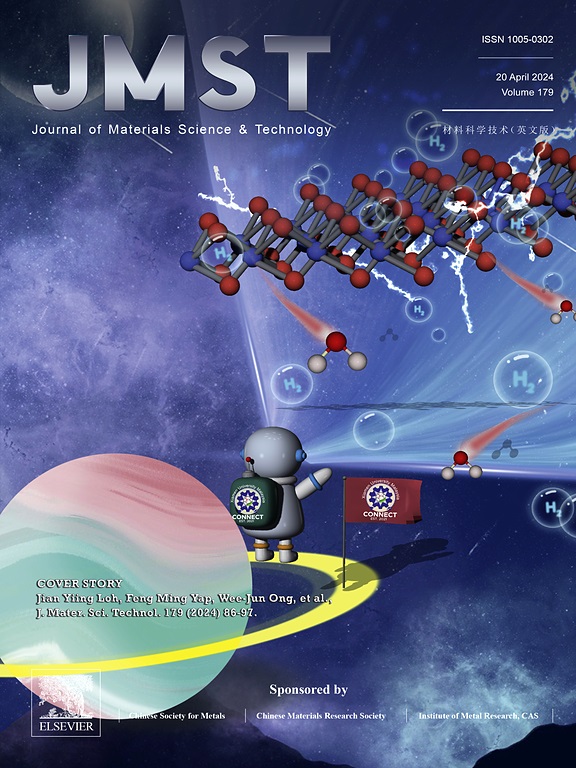双相介质陶瓷低温掺杂的协同楔效应
IF 11.2
1区 材料科学
Q1 MATERIALS SCIENCE, MULTIDISCIPLINARY
引用次数: 0
摘要
选择性离子掺杂是提高钙钛矿介电陶瓷综合性能的一种很有前途的方法。然而,介电常数(εr)、谐振频率近零温度系数(TCF)和质量因子(Q × f)之间的对抗仍然是高性能介电陶瓷的关键挑战。为了平衡这种权衡冲突,使用双相钙钛矿基介电陶瓷复合材料可能是一种潜在的理想解决方案。遗憾的是,由于钙钛矿相和钙钛矿相的烧结温度差异,所选择的离子很难掺杂到钙钛矿相中,从而严重影响了改性效果。本研究在MgTiO3-CaTiO3双相介质陶瓷复合材料中采用“楔形”策略,以Ce作为辅助掺杂剂,实现CaTiO3相中由于晶格畸变导致的Hf主掺杂。该策略还协调了CaTiO3和MgTiO3两种组分之间烧结温度差异的对抗。在烧结温度降低到200℃以上的情况下,成功地实现了高达40 mol.%的Hf4+掺杂。最重要的是,由于在CaTiO3相中成功地引入了高剂量的Hf掺杂剂,而没有牺牲MgTiO3的完整结构,因此εr、近零TCF和Q × f之间的权衡冲突已经大大减少和协调。该方法不仅为高性能双相介质陶瓷的研制提供了新的思路,同时也为解决多相陶瓷复合材料中选择性离子掺杂烧结温度不匹配的难题提供了一条创新途径。本文章由计算机程序翻译,如有差异,请以英文原文为准。

Synergistic wedge effect for low-temperature doping in dual-phase dielectric ceramics
Selective ion doping is a promising method to enhance the overall performance of perovskite dielectric ceramics. However, the confrontations among the dielectric constant (εr), near-zero temperature coefficient of resonant frequency (TCF), and quality factor (Q × f) remain key challenges in high-performance dielectric ceramics. To leverage the trade-off conflicts, using dual-phase perovskite-based dielectric ceramic composites could be a potentially ideal solution. Unfortunately, the selected ions are hard to be doped into the perovskite phase due to the sintering temperature disparity of the two phases, thereby significantly impacting the modification effect. In this study, a “wedge” strategy was employed in a MgTiO3-CaTiO3 dual-phase dielectric ceramic composite by using Ce as an auxiliary dopant to realize the main Hf doping in the CaTiO3 phase due to the lattice distortion. This strategy also harmonizes the confrontation of the sintering temperature disparity between the two components of CaTiO3 and MgTiO3. The Hf4+ doping level of as high as 40 mol.% with a reduced sintering temperature of over 200 °C was successfully achieved by using this “wedge” strategy. Most importantly, the trade-off conflicts among the εr, near-zero TCF, and Q × f have been considerably reduced and harmonized due to the successful introduction of a high dosage of Hf dopant in the CaTiO3 phase without sacrificing the intact structure of MgTiO3. This strategy not only sheds light on manufacturing high-performance dual-phase dielectric ceramics with trade-off conflicts of properties but also provides an innovative pathway to address the challenge of mismatch of sintering temperature for selective ion doping in multiple-phase ceramic composites.
求助全文
通过发布文献求助,成功后即可免费获取论文全文。
去求助
来源期刊

Journal of Materials Science & Technology
工程技术-材料科学:综合
CiteScore
20.00
自引率
11.00%
发文量
995
审稿时长
13 days
期刊介绍:
Journal of Materials Science & Technology strives to promote global collaboration in the field of materials science and technology. It primarily publishes original research papers, invited review articles, letters, research notes, and summaries of scientific achievements. The journal covers a wide range of materials science and technology topics, including metallic materials, inorganic nonmetallic materials, and composite materials.
 求助内容:
求助内容: 应助结果提醒方式:
应助结果提醒方式:


